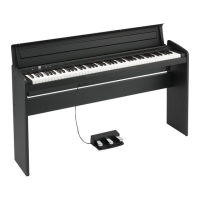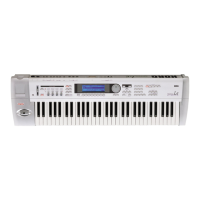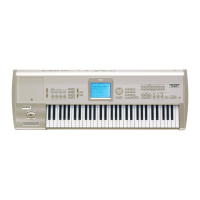Sampling mode
338
Insert
When you execute this command, the sample data placed in
the buffer by executing Copy in the Sampling mode Sample
Edit page will be inserted at the Edit Range Start address.
The data that follows this address will be moved toward the
end of the sample.
1. Use Sample Select (1–1b) to select the sample that you
wish to edit, and set “Start” to specify the starting
address. The “End” setting is ignored.
2. Select “Insert” to open the dialog box.
3. To “Start” will indicate the starting address at which
the data will be inserted.
4. In “Save to No.,” specify the save destination sample
number. By default, an unused sample number will be
selected.
The sample number cannot be specified if “Overwrite” is
checked. For more information, please see “About
“Overwrite”” on page 329.
For stereo samples, use “Save to No.(L)” and “(R)” to
specify the save-destination of the L and R channels.
5. To execute the Insert command, press the OK button.
To cancel, press the Cancel button.
If the buffer into which data was placed by the Copy
command contains no data, the display will indicate
“Source sample is empty.”
Mix
When you execute this command, the sample data placed in
the buffer by executing Copy in the Sampling mode Sample
Edit page will be mixed with the selected sample data,
starting at the Edit Range Start address.
1. Use Sample Select (1–1b) to select the sample that you
wish to edit, and set “Start” to specify the starting
address. The “End” setting is ignored.
2. Select “Mix” to open the dialog box.
3. To “Start” will indicate the starting address at which
the data will be mixed.
4. In “Save to No.,” specify the save destination sample
number. By default, an unused sample number will be
selected.
The sample number cannot be specified if “Overwrite” is
checked. For more information, please see “About
“Overwrite”” on page 329.
For stereo samples, use “Save to No.(L)” and “(R)” to
specify the save-destination of the L and R channels.
5. To execute the Mix command, press the OK button. To
cancel, press the Cancel button.
If the buffer into which data was placed by the Copy
command contains no data, the display will indicate
“Source sample is empty.”
Paste
When you execute this command, the sample data placed in
the buffer by executing Copy in the Sampling mode Sample
Edit page will be placed in the sample starting at the Edit
Range Start address. The original data will be deleted, and
overwritten by the sample data from the buffer.
You can also place sample data into a blank sample. This is
convenient when you wish to Copy part of a sample and
create a new sample based on it.
Pasting to a sample that contains sample data
1. Use Sample Select (1–1b) to select the sample that you
wish to edit, and set “Start” to specify the starting
address. The “End” setting is ignored.
2. Select “Paste” to open the dialog box.
3. To “Start” will indicate the starting address at which
the data will be pasted.
4. In “Save to No.,” specify the save destination sample
number. By default, an unused sample number will be
selected.
From the buffer
From the
buffer
From the
buffer

